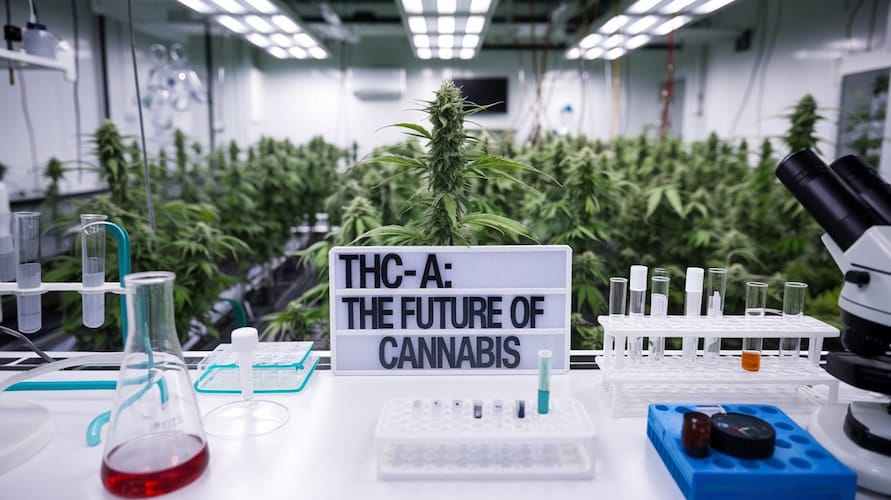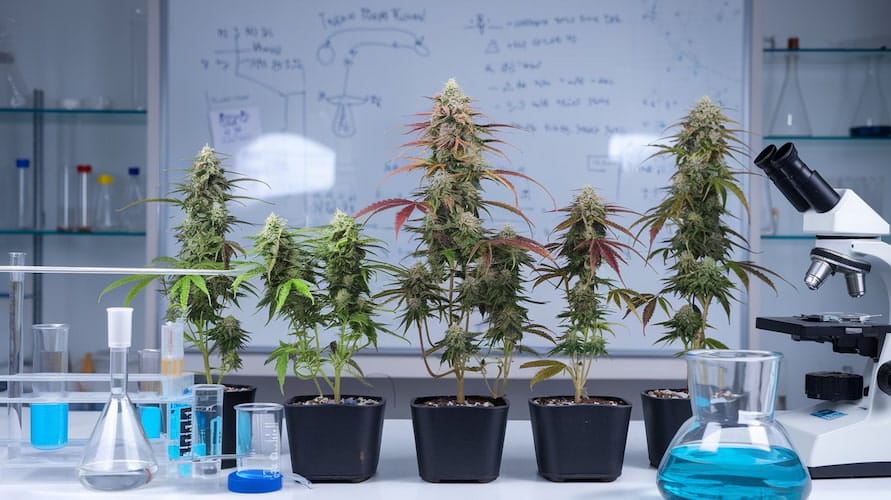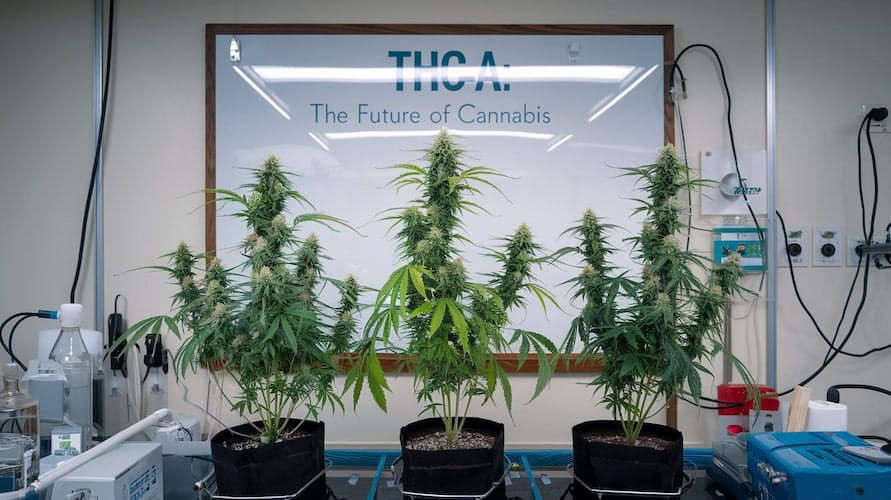The Science Behind THC-A: Is It the Future of Cannabis?

Hi, I’m James Bean, owner of Seeds Here Now. As someone deeply involved in the cannabis industry, I’m always exploring the unique properties of cannabinoids and how they might change the game for both recreational and medicinal cannabis. While THC and CBD dominate the market, THC-A—or tetrahydrocannabinolic acid—is starting to catch serious attention for its potential health benefits without the psychoactive “high.” Today, let’s dive into what THC-A is, how it works in the body, and whether it could become a major part of the future of cannabis.
What Exactly Is THC-A?
THC-A is a natural cannabinoid found in raw cannabis and is actually the acidic “precursor” to THC, the well-known psychoactive component. When cannabis is in its raw form, THC-A doesn’t produce any psychoactive effects, meaning there’s no “high” because it hasn’t yet been converted into THC.
This transformation happens through decarboxylation, which occurs when THC-A is heated—whether it’s smoked, vaporized, or baked into edibles. Once it turns into THC, it can bind with cannabinoid receptors in the brain, creating the effects THC is known for. Until then, though, THC-A stays non-psychoactive and retains its own unique potential.
How THC-A Works in the Body
Cannabinoids, including THC-A, interact with our endocannabinoid system (ECS)—a complex network of receptors, enzymes, and natural cannabinoids that help regulate everything from pain and mood to appetite and immune response. Unlike THC, which binds directly to the CB1 receptors in the brain to create psychoactive effects, THC-A doesn’t bind to CB1 or CB2 receptors, so it doesn’t cause a high.
But THC-A does interact with other parts of the ECS and even with receptors like TRPV receptors (transient receptor potential vanilloid). These receptors help regulate things like pain and inflammation, which is why THC-A is now being explored for benefits like pain relief and anti-inflammatory effects.
The Potential Health Benefits of THC-A
Although research into THC-A is just beginning, early studies and personal accounts point to some big potential. Here are a few of the possible health benefits that could make THC-A a new star in medical cannabis.
1. Anti-Inflammatory Benefits
Why It Matters:
THC-A shows strong potential as an anti-inflammatory. Unlike some traditional anti-inflammatory medications, THC-A doesn’t come with certain side effects, making it an appealing option.
Who It Helps:
People with conditions linked to chronic inflammation, like arthritis, Crohn’s disease, or multiple sclerosis, might benefit from THC-A. Since it doesn’t cause a high, patients can use it without the psychoactive effects getting in the way of daily life.
2. Neuroprotective Effects
Why It Matters:
THC-A may protect the brain and nervous system from damage, which could make it useful for people with neurodegenerative diseases like Alzheimer’s or Parkinson’s.
Who It Helps:
Early studies, including one in the British Journal of Pharmacology, suggest that THC-A could slow down neuron degeneration, possibly improving the quality of life for people with degenerative diseases.
3. Anti-Nausea Properties
Why It Matters:
THC is already known for reducing nausea, especially for chemotherapy patients. THC-A also shows anti-nausea effects but without the high.
Who It Helps:
For people dealing with severe nausea—like those undergoing chemotherapy or living with gastrointestinal issues—THC-A may offer relief without cognitive side effects.
4. Pain Relief
Why It Matters:
THC-A may have analgesic (pain-relieving) properties, though not as strong as THC. However, its non-psychoactive nature could make it a practical option for people seeking natural pain management.
Who It Helps:
Patients with chronic pain from conditions like fibromyalgia or back pain may find THC-A provides relief without affecting mental clarity.
5. Potential in Weight Management
Why It Matters:
Some studies hint that THC-A may help with metabolism and appetite control, potentially supporting weight management.
Who It Helps:
In a world where obesity is a growing issue, THC-A could play a role in healthy weight management when combined with lifestyle adjustments.
THC-A vs. THC vs. CBD: How They Differ
So, how does THC-A compare to its better-known counterparts, THC and CBD?
- Psychoactivity: Unlike THC, THC-A is non-psychoactive, making it suitable for people who want the benefits of cannabis without the high.
- Medical Uses: THC-A shares some benefits with CBD, like anti-inflammatory and anti-nausea properties. However, THC-A has unique neuroprotective potential, which might make it especially valuable in treating neurodegenerative conditions.
- Legal Status: THC-A’s legality is complicated. Since it’s not psychoactive until heated, some places with strict THC laws allow THC-A products. But this varies by state and country, so it’s always good to check local regulations.
Current Research on THC-A
Though the research is still emerging, studies suggest that THC-A could be a powerful therapeutic tool. Here’s a closer look at the areas scientists are exploring:
1. Neurodegenerative Disease Support
What We Know:
Research shows that THC-A may help prevent oxidative stress—a key factor in diseases like Alzheimer’s and Parkinson’s. It might also protect neurons, preserving cognitive functions.
2. Anti-Inflammatory Effects
What We Know:
A 2011 study showed that THC-A and other cannabinoids can reduce cellular inflammation. This makes it a promising option for conditions like rheumatoid arthritis.
3. Anti-Cancer Research
What We Know:
Preliminary studies suggest that THC-A could inhibit cancer cell growth by inducing apoptosis (cell death). This research is still highly experimental but promising for future applications.
How To Use THC-A: Methods and Considerations
If you’re interested in trying THC-A, there are a few ways to consume it while keeping it in its raw form. Here are the main options:
1. Juicing Raw Cannabis
How It Works:
Juicing fresh cannabis leaves and buds lets you consume THC-A without heating it. Just blend with fruits or veggies, and you’re good to go.
2. Tinctures and Capsules
How It Works:
Some brands offer THC-A in tincture or capsule form. These products are lab-tested to confirm their THC-A content, making them a reliable option.
3. Topicals
How It Works:
THC-A-infused topicals, like creams and balms, can be applied to the skin for localized relief from inflammation or pain.
Legal Status of THC-A: A Gray Area
The legality of THC-A varies widely. Here’s a quick look at how it stands in different regions:
- United States: THC-A is often regulated the same as THC because of its potential to convert. Some states, however, allow THC-A in hemp products, depending on local laws.
- Canada: Canada’s Cannabis Act treats THC-A like THC, so it’s typically restricted.
- European Union: THC-A products over 0.2% THC are prohibited, but laws differ by country.
As research and regulations evolve, we may see THC-A gain a clearer legal footing and become more available.
THC-A’s Role in the Future of Cannabis
With its therapeutic benefits and non-psychoactive properties, THC-A could become a key player in cannabis. Here’s what the future might look like:
1. Pharmaceuticals
As research advances, pharmaceutical companies might develop THC-A-based medications for conditions like neurodegenerative diseases and chronic inflammation.
2. Wellness Products
THC-A could show up in health products like anti-inflammatory supplements, weight management aids, and neuroprotective dietary supplements.
3. Broader Market Availability
As awareness grows, more cannabis brands will likely develop THC-A-specific products like tinctures, capsules, and topicals.
4. Dietary Supplements
Imagine THC-A becoming as common as multivitamins! Juicing raw cannabis or adding THC-A-rich ingredients to daily meals might become a popular wellness trend.
Conclusion: Is THC-A the Future of Cannabis?
The potential for THC-A in the cannabis world is exciting. Its non-psychoactive nature makes it accessible to more people, and its health benefits could change lives. But to fully unlock THC-A’s potential, we need continued research and clearer regulations.
For those interested in what’s next, THC-A is a fascinating cannabinoid to watch. As science continues to uncover its therapeutic power, THC-A could truly be the next big thing in cannabis.
FAQs
What’s the difference between THC and THC-A?
THC is psychoactive, while THC-A isn’t unless it’s heated, which converts it into THC.
Is THC-A legal to use and purchase?
The legality of THC-A varies; it’s often regulated similarly to THC in places with strict cannabis laws.
How can I consume THC-A without converting it to THC?
Juicing raw cannabis or using THC-A tinctures and capsules are effective non-psychoactive methods.
What conditions can THC-A help treat?
THC-A shows promise for inflammation, neuroprotection, nausea, and chronic pain.
Is THC-A available in most cannabis dispensaries?
THC-A products are emerging in dispensaries but may not be widely available due to legal limitations.
Suggested Articles
;)
;)
;)






 03 Jul 2025
03 Jul 2025  10 min read
10 min read


 December 17, 2024
December 17, 2024 


RESPONSES (0)
No responses yet. Be the first to respond!